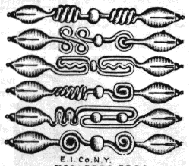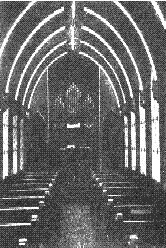
The next researcher whose work contributed to the development is Abbe Nollet. In 1749, he made some special vacuum tubes with wires sealed in one end. These tubes were referred to by Nollet's contemporaries as "electrical eggs", and indeed these eggs did hatch something - X rays.
 Skip forward about 100 years,
and things really start jumping.
In the 1850s, Heinrich Geissler, a skilled glassblower,
started producing what was probably
the first discharge tube art.
His intricately shaped glass tubes,
filled with a variety of gases,
glowed with a lovely variety of shapes and colours.
Geissler also invented the mercury diffusion pump,
which was needed to produce the good vacuum inside
his tubes.
This sort of tube bears Geissler's name to this day.
Skip forward about 100 years,
and things really start jumping.
In the 1850s, Heinrich Geissler, a skilled glassblower,
started producing what was probably
the first discharge tube art.
His intricately shaped glass tubes,
filled with a variety of gases,
glowed with a lovely variety of shapes and colours.
Geissler also invented the mercury diffusion pump,
which was needed to produce the good vacuum inside
his tubes.
This sort of tube bears Geissler's name to this day.
Then came Julius Plücker, who studied Geissler's tubes and learned how to concentrate and direct the discharge with magnets and tubing with a varying bore. Again, Plücker's name lives on today, applied to the spectrum tubes fabricated with his techniques.
In 1859, Antoine Henri Becquerel described making tubes containing luminescent materials and rarified air. These tubes probably represent the first examples of fluorescent light production, which is used today for phosphor coated neon tubes.
In 1893, Nicola Tesla produced the first phosphor coating. The sign he made, which read "LIGHT", only worked for a short time, however.
 In 1898, Moore filled long tubes with a mixture of carbon dioxide and nitrogen
to produce fairly efficient electric light.
His solution to the problem of the gases being absorbed by chemical reactions
and the electrodes was a simple valve that admitted additional gas when needed.
This image is of the Moore chapel in Madison Square Gardens, lit with Moore tubes.
In 1898, Moore filled long tubes with a mixture of carbon dioxide and nitrogen
to produce fairly efficient electric light.
His solution to the problem of the gases being absorbed by chemical reactions
and the electrodes was a simple valve that admitted additional gas when needed.
This image is of the Moore chapel in Madison Square Gardens, lit with Moore tubes.